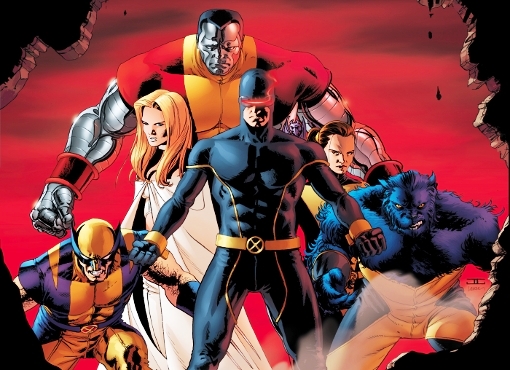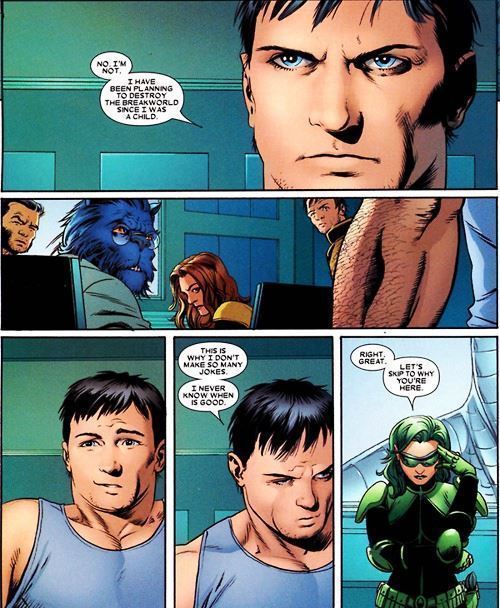
I’ve often wondered what it is about Joss Whedon that sends geeks into a near religious fervor when his name gets mentioned. It’s not that I don’t think he deserves it—his accomplishments in the world of geekery are legendary enough for such high regard. So, perhaps the question to ask is this: Why are his properties so successful? After taking a close look at the stories that he’s been involved with, one common denominator always pops up:
The dude gets relationships.
If the story involves characters who have to depend on one another to survive, Whedon can make it applicable to all of us. That being said, it’s a no-brainer that he eventually found his way to the X-Men. Not only do the X-Men have to deal with the everyday superhero crap of battling megalomaniacs and preventing the destruction of Earth, they have to do so with full knowledge that a large chunk of society hates them. It’s easy for Spider-Man to thwip his way around New York and protect the innocent—everybody loves that guy. But to maintain that same moral compass in the face of blatant intolerance and hatred? That’s so much more than heroic.
It’s astonishing.
In 2004—well before Whedon put his team-building skills to work bringing together one of the most ambitious cinematic projects in recent memory—he and artist John Cassaday brought the X-Men to life with a 24-issue run of “Astonishing X-Men,” and it’s about as perfect as comics come. Taking Whedon’s flair for exploring the relationships among flawed heroes through clever dialogue and pairing it with Cassaday’s superbly rendered character designs represents just about everything that I love about the comic book medium.
From the very first issue, it’s Whedon’s goal to show the reader that these characters are less of a superhero team and more of a dysfunctional family that is coming back together after a really long break from one another. Right at the get-go we see just how much baggage each member of the X-Men is bringing to the table. As Kitty Pryde makes her way through Xavier’s mansion for the first time in what seems like eons, old memories taken from classic X-Men issues resurface, revealing the pack of insecurities that Pryde has about herself as a hero. When Logan shows up at the foot of Scott’s bed and makes a snide comment about Jean, the two of them proceed to kick the shit out of each other on the school grounds. Hank is still nursing some deep-seeded issues about his own furry blue genetic mutation. Pyotr has spent untold years as a lab rat and upon his release is smacked with the news that he may or may not be responsible for interplanetary genocide. And let’s not overlook the emotional minefield that lurks behind Emma Frost’s cold exterior. Apart from nursing some serious guilt issues that stem from her time in the Hellfire Club, she’s having difficulties coming to terms with Scott’s use of the “L” word.

Despite cutting quickly to the core of each teammate’s insecurity, another thing that “Astonishing X-Men” does well is its reinvention of the team. After the altercation between Cyclops and Wolverine, the team gathers to discuss the role of the X-Men in the superhero world. I typically join the majority of X-Men fans with the declaration that Cyclops is, for the most part, a complete tool. However, his vision for creating a team of mutants that is more public-friendly is a great catalyst to move the team from the black leather-clad days of Ultimate X-Men, which, as Cyclops puts it, “Made people nervous.” Throughout the storyline, Cyclops actually has some moments that showcase his role as a leader—not the kind of leader that assumes a level of entitlement, but a leader that inspires loyalty by being the best example of the qualities that he’s looking for in a team and making sure he sticks to those pearl-handled guns. It’s clear that Cyclops expects each of his team members to sacrifice themselves for the good of the team because he does it himself on so many occasions. Yet, these sacrifices do not come across as self-righteous martyrdom since he always manages to have an ace in the hole. As far as I’m concerned, “Astonishing X-Men” can provide enough material for Cyclops apologists—I know you’re out there—to produce a pretty convincing case that the one-eyed boyscout is actually a badass.
In addition to the “mutant cure” storyline that was used to lackluster effect in Brett Ratner’s third “X-Men” film, Whedon puts the heroes on an epic trajectory that takes our heroes across the galaxy to the Breakworld, home to a civilization where compassion is considered a genetic mutation. Along the way, he manages to make a few additions to the X-Men canon. Most notable is the organization known as S.W.O.R.D. (Sentient World Observation and Response Department) which is the sister organization to S.H.I.E.L.D. Led by the mysterious Agent Brand, S.W.O.R.D. is in charge of keeping diplomatic relationships among Earth and other planets intact. The X-Men themselves recruit a new team member named Hisako Ichiki who calls herself Armor because of her ability to project a powerful, robot-shaped force field around herself. One of the more intriguing subplots in the Breakworld story is the surfacing of Danger, which is the consciousness of the X-Men’s Danger Room that becomes self-aware and takes the shape of Lady Gaga by way of the Predator.
As my brain is more wired to observe the story of an amazing comic book, that’s where I tend to wander. However, it would be an egregious sin to not at least touch upon the quality of John Cassaday’s artwork. Do keep in mind that I am not an art critic, so if I venture into the plebian vernacular of “sweet” and “awesome,” please check your judgment at the door. The best way to describe the style that Cassaday brings to Whedon’s story is that he has managed to perfectly capture the line between “real person” and “superhero.” I’m used to my superheroes looking, well, superhero-y—flawless bodies, skin-tight clothing, etc. Though Cassaday’s renditions of the X-Men still capture the imposing grandeur of our heroes, they somehow manage to look like people who one would expect to encounter in real life. Amid his skill at capturing grandiose scenes of action and carnage, Cassaday’s real talent is in guiding the reader’s focus to the faces of his subjects. It’s their facial expressions that bring them to life, and that’s something I haven’t seen very often in the pages of comic books. It’s pretty sweet. And awesome.

As someone who was raised on the Claremont-era X-Men, I was a bit turned off by the direction that the subsequent X-Men reinventions took. The team seemed to adopt the stigma that society had saddled them with by becoming more anti-heroic than heroic—which meant that they had already lost their most important battle. After cracking open the first issue of “Astonishing X-Men,” and seeing the incorporation of scenes that I remembered from my younger days, I felt as if I was being welcomed back into a world that I thought had been sacrificed to the dismal and occasionally mean-spirited world of Ultimate X-Men. Whedon’s and Cassaday’s “Astonishing X-Men” made me feel like these heroes, who have always been more than just pretty faces and superpowers to me, were back in the roles that still speak to so many members of our society.